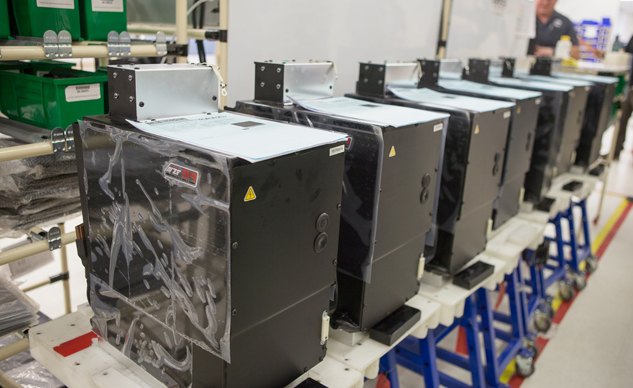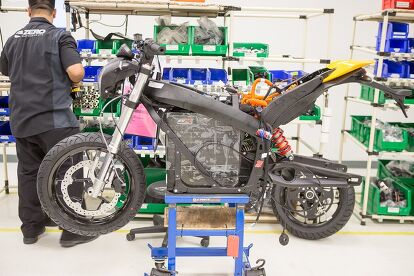Inside Batteries: Zero Motorcycles Senior Battery Specialist, Luke Workman + Video

Inside the mind of a mad scientist
For as many benefits as electric motorcycles provide, to date there are still two areas preventing e-bikes from penetrating through to the masses: range and price. There’s not enough of the former, and there’s too much of the latter. Zero Motorcycles’ Senior Battery Specialist, Luke Workman, is dedicated to furthering the performance of battery technology. The results, then, would lead to ever increasing range at a price affordable by the masses.
Motorcycle.com recently had a chance to sit down with Workman and pick his brain about EV technology. Here we bring you some highlights of our conversation, along with a supplemental video with some rather bold predictions. Definitely give it a watch.
When looking at Workman’s progress, consider this: when he started with Zero in 2011, the motorcycles only had a 40-mile range. Luke’s first battery iteration doubled that, with the next iteration doubling the range yet again. While doing so, Workman and the Zero team also upped other performance aspects like acceleration and top speed. This works differently than in the internal combustion world, where fuel efficiency is often synonymous with lackluster performance. Unlike battery developers for the car world, however, who have virtually endless space to stuff batteries, Workman faces a specific challenge: increasing the amount of energy density given the confines of a motorcycle’s limited space, all while remaining incredibly safe.
It’s a challenge Workman relishes, as he’s not only an engineer but also an avid motorcyclist. To him, the advancement of electric technology is personal. While he declined to give the recipe inside Zero’s batteries, as it’s proprietary information, he did, however, describe their architecture, which is unique in the EV world. Zero’s partnership with Farasis, a lithium-ion battery company just down the street from Zero in Hayward, California, has produced what Workman says is the most energy-dense electric vehicle battery on the market today.
Each individual battery (internally known as a cell box, and colloquially termed “bricks”) contains 28 flat cells from Farasis. Each cell is 3.6 volts, which added together makes for roughly 100 volts. All Zero motorcycles purposely operate at 100 volts for safety concerns; getting zapped with 100 volts (say, if you’re a Zero technician) will hurt, but up the voltage to 300, which is where many electric cars operate, and it’ll kill you.
Typically, battery packs in, say, electric cars use cylindrical cells. These cylinders not only take up more space, making them less efficient, but they also have less power capacity than Zero’s flat-cell design. Since a car has considerably more space, the answer is simply to stuff more batteries to fit.
Individual bricks are what power the Zero FX model. Add three or four bricks together and you have what’s known as a “monolith” in Zero terms, which powers the S, SR and DS models. The three-brick monoliths are currently featured in ZF9.4 models, while the four-brick monoliths are used for ZF12.5 models. Zero’s optional Power Tank is simply a single auxiliary brick.
Zero assembles each cell box and/or monolith in-house, and the company has recently converted an adjoining building at its Santa Cruz headquarters solely for this task. Each battery pack is then given numerous stress tests, like being soaked in a shower for 30 minutes, before getting the stamp of approval.
What Does The Future Hold?
One of the many technologies Workman is optimistic about involves the use of solid-state electrolytes, which omits the liquid electrolyte currently used in batteries today. Solid-state electrolytes would not only be safer to produce, but have the potential for greater energy densities. Cells would then be smaller and more robust, Workman says.
Other technologies on Workman’s radar screen include magnesium-ion-based batteries, metallic magnesium-based batteries, sulfur-based anode materials and silicon-based anode materials. Workman says each technology currently faces hurdles with cyclic and discharge stability, but there are several teams with big budgets working to solve these issues. These are “enabling technologies for many next generation battery technologies to thrive,” he says. “The limit is something greater than 10 times over where we are today.”
Workman declined to talk about current projects he’s working on, but he was solid in his conviction that the age of electric vehicles is in our future. Watch the video above to hear more from Workman, including his prediction for the future of the internal combustion engine.

Troy's been riding motorcycles and writing about them since 2006, getting his start at Rider Magazine. From there, he moved to Sport Rider Magazine before finally landing at Motorcycle.com in 2011. A lifelong gearhead who didn't fully immerse himself in motorcycles until his teenage years, Troy's interests have always been in technology, performance, and going fast. Naturally, racing was the perfect avenue to combine all three. Troy has been racing nearly as long as he's been riding and has competed at the AMA national level. He's also won multiple club races throughout the country, culminating in a Utah Sport Bike Association championship in 2011. He has been invited as a guest instructor for the Yamaha Champions Riding School, and when he's not out riding, he's either wrenching on bikes or watching MotoGP.
More by Troy Siahaan










































Comments
Join the conversation
Great video/article guys! I usually just tell people it's full of Duracells when they get curious what just passed them on the track.
Thanks. One of the most informative interviews ever.